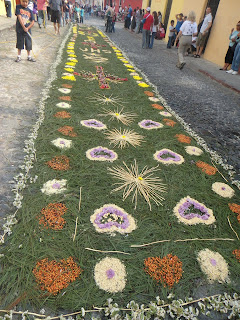Michelle writes:
This morning I had the opportunity to accompany Dona Rosa and Rosa to the playa. The playa is a flat expanse where everyone from the village has a portion of land to grow their basic foods: maize, beans, and squash. Today, I witnessed the beauty of the three sisters, as these vegetables are called, with their complementary growth pattern. The acres spread before me in the morning mist as we arrived at the playa.
Dona Rosa had said to be ready at 5 a.m., when the morning was clarito (clear enough to see your way in the dawn light). At 5:20, she arrived at Kathy’s home.
Rosa, leaving her 10-month-old twins at home, had come a few minutes before, making sure she was there to join us. I turned off the headlamp I was using and joined them. The morning light was weak, but we were able to discern the uneven terrain of the road as we left the village.
The air was brisk; when I had checked, it was 70 degrees. For here, that felt cool. If I were home in Idaho on this April day, I would have been jubilant for the unseasonable warmth. I wore a long sleeve shirt over my T-shirt, but not for long, as the sweat began to bead with the movement and humidity.
For an hour, we walked on the new road, up and down, following the lay of the land. Leaving the road, we dropped down into the field and crossed a creek on a log that had been whittled, making a flat and irregular surface to provide traction during the rainy season.  As we started across the flats, Dona Rosa used her machete to slap at the vegetation we walked through. Snakes are a common concern in the tall grass.
As we started across the flats, Dona Rosa used her machete to slap at the vegetation we walked through. Snakes are a common concern in the tall grass.Dona Rosa’s garden is close to the road, and we saved another hour's walk by not having to travel to the far end of the community garden. The maize was drying on the stalks, heavy ears drooping. At her garden, I saw the quisguil that Dona Rosa planted, vining on the stalks and lone tree. This squash is boiled for its sweet flesh.
I followed Dona Rosa as she made her way through the lush, dew-moist, vegetation. Rosa took a large cloth and slipped the ends into the waist of her skirt as she followed us. The dew is so heavy that your clothes are wet after a few paces.
 Dona Rosa and Rosa started picking the day's harvest: squash blossoms, young tender leaves from the squash, and various squash, along with another hierba, one of the many that create the thick lush carpet.
Dona Rosa and Rosa started picking the day's harvest: squash blossoms, young tender leaves from the squash, and various squash, along with another hierba, one of the many that create the thick lush carpet. I followed, carrying the bounty, and reflecting on how my life had been guided once again. I am here, sharing an experience with a Mayan matriarch, learning the ways of the Maya and their connection to the earth. This culture is centuries old, and I am part of it, here in this quiet little corner of the world where life still remains much as it has always been, gathering the local wild plants for a simple but nutritious diet.
We returned to the lone tree, which I realized is the landmark in this maze of maize. Here we placed our armsful of fresh produce in the center of a brightly woven cloth, tied the corners together, and securing the load to carry home. Dona Rosa had brought breakfast: scrambled eggs, tomatoes cooked with onions, and, of course, tortillas. I had brought almonds, which were something new for both Rosas.
Dona Rosa, one of the leaders of the village, embraced me, the gringa, with her culture. She had allowed me to accompany her the other evening as she visited three pregnant women whose births she will attend. As the local midwife, she visits the mothers weekly. ,While at the homes, she felt for the position of the baby and turned the one baby that was posterior. She allowed me to check for the baby's position as well. Through Kathy, I told her I had a home birth and had attended four other births, after basic midwife instruction. She was happy to share her skills with me.
After breakfast, we gathered more hierba, punte ayote, and squash before setting off for home. Dona Rosa’s carga, the fabric-wrapped bundle, was heavier than my mochila, backpack, so I told her we could switch loads. She was surprised.
I carried the carga using the head strap as she slipped on the backpack. Salvador, the local hero, was visiting Kathy when we arrived. After unloading my backpack of freshly-picked produce, Dona Rosa and I joined Kathy and Salvador for a glass of cold rosa Jamaica, hibiscus tea. After a quick demonstration of how to prepare the squash blossoms, leaves, and tendrils, I was ready to make our meal. Salvador helped. With left-over potato water, onions, garlic, and tomatoes, the greens and blossoms became a delightful, tasty meal. Salvador confirmed that this is the food of the Maya.

























































